‘More a Volunteer than a member of Cumann na mBan’
Published in Decade of Centenaries, Features, Issue 5 (September/October 2017), Volume 25The story of Mary O’Dwyer.
By Oisín Ó Síocháin
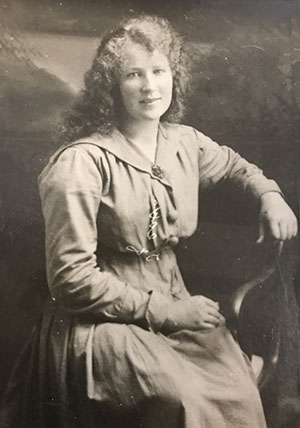
Above: Mary O’Dwyer c. 1920. (Adrian Corcoran)
The following year, aged eighteen, Mary joined Cumann na mBan and was soon promoted to captain of E Company, 7th Battalion, 3rd Tipperary Brigade, the brigade that fired the first shots of Ireland’s War of Independence at Soloheadbeg.
None of Mary O’Dwyer’s family were involved in republican activities. Actually, she ignored advice not to get involved. One Sunday morning, according to a Bureau of Military History statement, the parish priest advised all the local women not to have any sympathy with the IRA, but she ignored him and remained a member of Cumann na mBan. In fact, she developed into a very active member, as well as carrying out all the more routine duties. In the words of Dan Breen, ‘She took big risks during the fighting … all the risks of a Volunteer’ and became ‘more a Volunteer than a member of Cumann na mBan’.
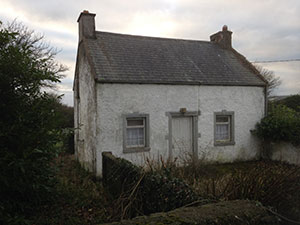
Above: The small, two-roomed house in Dualla, South Tipperary, where Mary O’Dwyer was born in 1902.
The first major event that involved Mary O’Dwyer was the Newtown ambush. An RIC bicycle patrol left the barracks in Ballinure, between Cashel and Killenaule, on the second day of every month to collect pay in Cashel. Unbeknownst to the patrol, it had been for some time under surveillance by Mary, on the orders of Comdt Tommy Donovan. She reported her information back to Donovan, and it was decided to ambush the patrol on 2 July 1920 at a crossroads at Newtown, midway between Dualla and Ballinure (see map).
On that day the patrol consisted of four men—Sergeant Robert Tobin, Constable Brady and Constable Moloney of the RIC, and one Auxiliary, Constable David Ross, from Scotland. The ambush party consisted of six IRA men—Tommy Donovan, Seán Hayes, Seán Walshe, Michael Burke, Paul Mulcahy and Joseph Ormond. According to Mulcahy, their plan was to call on the constables to halt and only to shoot if resistance was offered. He wrote, ‘We did not consider seriously the fact that they might offer resistance’, but this is exactly what happened.
At about 4.30pm the RIC patrol arrived at Newtown Cross. What happened next is not entirely certain, as there is conflicting information in the different sources. It appears, however, that the IRA called on the patrol to halt, but they jumped off their bicycles and ran for cover. According to the RIC, the IRA opened fire first, while Mulcahy and Tierney said that Sgt Tobin fired first. What is certain, however, is that Robert Tobin, 42 years old and married with six children, was shot and killed. He was one of 46 RIC men killed in Tipperary between 1919 and 1922.
Const. Brady bravely started to cycle towards Dualla for help. He was under fire and was wounded in the lower abdomen. Despite this he kept cycling, but when he got to Dualla he collapsed. One of the Volunteers had been ordered by Donovan to pursue and shoot Brady, but he found a group of locals gathered around the wounded constable and so he refrained from carrying out his orders. Brady went on to live to a very old age in Clonmel.
Back at the ambush site, the remaining two constables were disarmed and released. Then the IRA, with the captured arms and bicycles, withdrew. Mary O’Dwyer took revolvers and ammunition from the IRA men and scouted the road for them so that they could make a safe escape. It is interesting to see that Mary O’Dwyer was involved in both setting up this ambush and helping the men’s getaway. Michael Burke, one of those involved, wrote that ‘the success of this ambush was considerably helped by her efforts’.
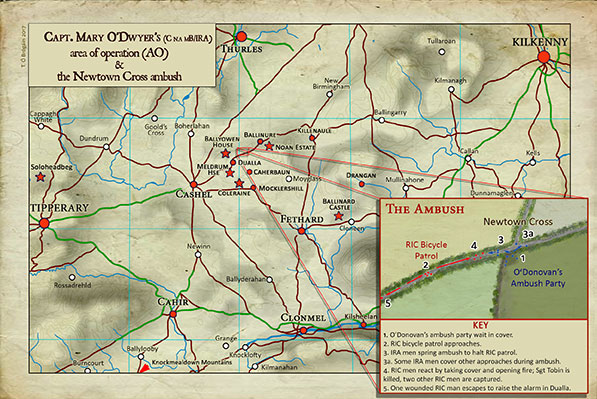
The capture and killing of David Cummins
Spies and informers were a serious threat to the republican movement and the IRA dealt with them very harshly. Most of the time they were shot dead as an example to others. County Tipperary was no different, and sixteen spies were killed there during the War of Independence.
David Cummins worked as a chauffeur for Frederick Armitage of Noan House, a landlord with a large estate in the Ballinure area. Cummins, a 34-year-old Protestant and originally from Donegal, had served in the British Army during the First World War. He was suspected by the IRA of being a spy. It is possible that he may not have been and that he had fallen under suspicion simply because he was an ex-British Army soldier and an Ulster Protestant who now worked for a local loyalist landlord.
On 8 July 1921, Mary O’Dwyer was sent by Ned O’Dwyer, her future husband, to scout the Noan estate to make sure that it was clear of Crown forces. She reported back that it was clear and they, with others, entered and captured Cummins in the stables. He was brought to Meldrum House nearby, where only a caretaker was living. While the execution was carried out, Mary was on lookout duty outside the house. Cummins’s body was then brought to the roadside at Dualla, with a notice stating ‘Convicted Spy; Spies and Informers Beware’.
Why was Mary chosen for involvement in the capture and death of Cummins? Firstly, she was known to be reliable. Geraldine Purcell, president of the 1st Battalion of Cumann na mBan, later wrote that she ‘was an excellent officer and was always at her post when required either night or day’. Secondly, as she had demonstrated at the Newtown ambush a year earlier, she was known to be capable of carrying out difficult orders. Thirdly, Mary was from Coleraine, which is very close to Noan, Meldrum and Dualla, and she knew this area very well.
Truce and Civil War
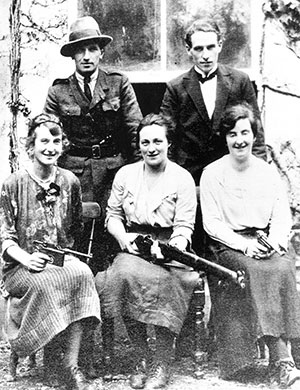
Above: The IRA officers’ training camp set up at Ballinard Castle after the Truce in July 1921. (Seán Sharkey)
Ballinard Castle, surrounded by a wood, was an ideal place for a training camp. There were lots of sheds and buildings around the castle, which were used for accommodation. The castle was owned by William Quirke, an intelligence officer in the 3rd Tipperary Brigade. Mary O’Dwyer attended the camp for three weeks and catered for the men, as well as organising dances for them. In fact, she used to say that ‘joining Cumann na mBan improved my social life dramatically’. A number of photographs of this training camp were taken by Lt. Seán Sharkey, and these seem to show that there was a relaxed atmosphere there.
Following the signing of the Treaty, most of the IRA and Cumann na mBan in the 3rd Brigade’s territory opposed it, including people like Dan Breen and Dinny Lacey. Mary O’Dwyer also went against the Treaty and was now in a difficult personal situation, as a lot of those in the National Army were her former comrades. Her activities during the Civil War were just as dangerous as those in which she had been involved during the War of Independence. During this period she was working as an attendant in Clonmel District Mental Hospital; she spied on the National Army forces in the town and reported back to the IRA. She also scouted for Dan Breen’s flying column in the area between Drangan and Dualla. On one occasion Breen sent her to Thurles to gather information on the strength of the National Army forces there, but she was identified, caught and arrested. She was released after four nights.
Mary continued as a captain in Cumann na mBan until the end of the Civil War in May 1923. According to her friend in later life, Pat O’Donnell, she only reluctantly accepted the Free State and remained sympathetic to the original aims of the republican movement.
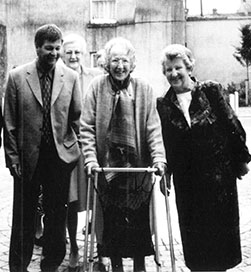
Above: Mary O’Dwyer entering a civic reception that was hosted by Cashel Urban District Council to mark her 100th birthday in 2002.
Mary married Edward (Ned) O’Dwyer after the Civil War. Ned was a member of the 2nd Battalion and, with Mary, had been involved in the capture and killing of David Cummins. He had also served in Dinny Lacey’s flying column during the Civil War. The O’Dwyers had three children, Philomena, Joan and Angela, and the family lived in Kilsheelan, near Clonmel. In the late 1940s they bought a farm in Caherbaun, just across the road from Mary’s birth place of Coleraine. Following Ned’s death in 1971, she sold the farm and moved to nearby Mocklershill. Later, her daughter and son-in-law, Joan and Colm, came here to live with her.
In the final years of her long life she was often visited by people who were interested in the War of Independence and republicanism. These included Martin O’Dwyer, who wrote a number of books on Tipperary’s War of Independence, and Pat O’Donnell, who shared her interests. Some of the more famous people who called on her were Fr Des Wilson, who, in Gerry Adams’s opinion, ‘was central to efforts to develop a peace process years before it eventually took root’, and Fr Paddy Ryan, the ‘republican priest’, who was wanted by Scotland Yard and who stayed at her home on occasions. In fact, Fr Ryan was eventually found by Gardaí during a raid on her house in 1992. She was 90 years of age at the time.
Mary O’Dwyer lived to be 100 years old. A civic reception was held in her honour in 2002 by Cashel Urban District Council, which she greatly enjoyed. She also had a birthday celebration in Dualla, with family and friends, which was also attended by Minister Noel Davern TD. On that occasion she proudly wore her medals. Mary died in St Patrick’s Hospital, Cashel, on 29 March 2003. She now rests in Dualla, the ‘patriot village’, alongside her husband, Ned, another veteran of the War of Independence. Her grave lies within yards of the impressive monument to Pierce McCan, who inspired her to fight for Irish freedom.
Oisín Ó Síocháin is a student in Gaelcholáiste Choilm Baile an Chollaigh, Co. Chorcaí.
Read More:
Ambush associates
Was Cummins a spy?
Decade of Centenaries all-island schools’ history competition 2018
FURTHER READING
L. Gillis, Women of the Irish Revolution (Cork, 2014).
P. Ó Ruairc, Truce: murder, myth and the last days of the Irish War of Independence (Cork, 2016).
J. Reynolds, 46 men dead: the RIC in County Tipperary 1919–1922 (Cork, 2016).
N. Sharkey, ‘The Third Tipperary Brigade―a photographic record’, Tipperary Historical Journal (1994), 9–25.
















